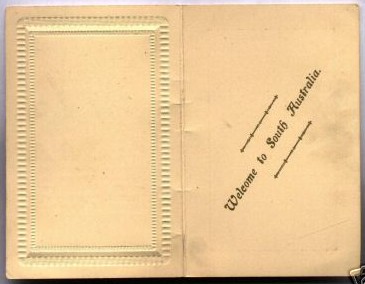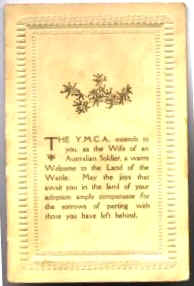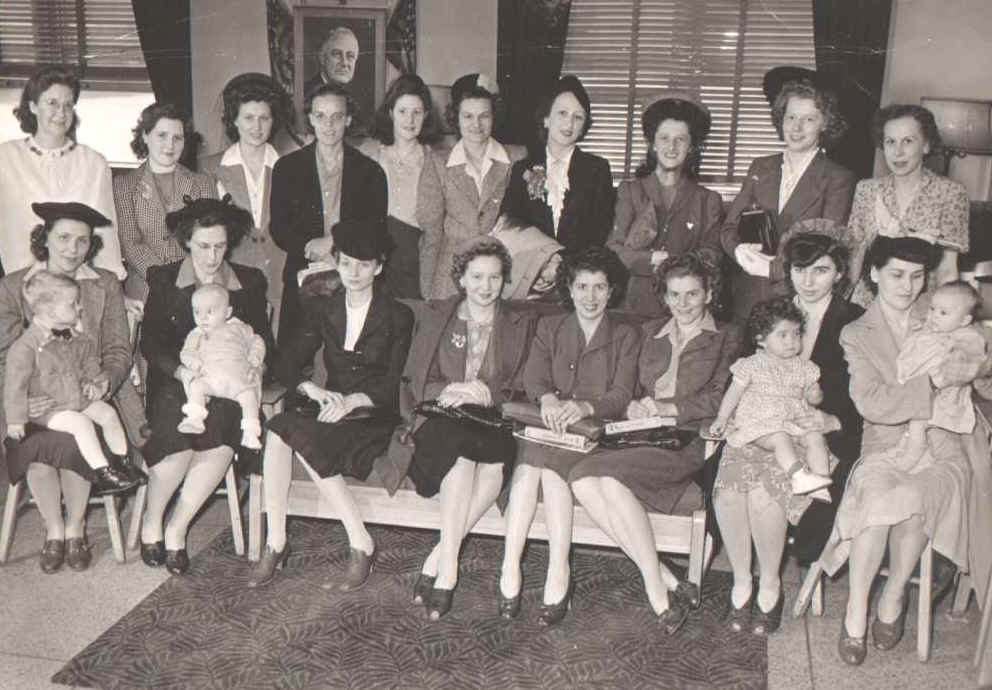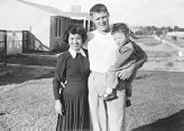 |
| Category: Army
History/WW2 |

|
|
|
|
|
 |

|
| These
"Welcome" booklets were produced by the YMCA of South
Australia to make welcome the WW1 war brides that accompanied Diggers
home from England France and other countries. |
 |
| These Canadian War
Brides are on their way to New
Zealand, having married NZ men in Canada for the Empire Air Training
Scheme (EATS) in WW2. RCAF photo |
 |
LOVE
& WAR: Stories of War Brides from the Great War to Vietnam
By Carol Fallows
Bantam Books, 256pp
In August 1916, during World
War I, a young Australian soldier billeted in France wrote a
letter to his mother about an adorable girl he had met. "Loulou
is really a brilliant girl, but like all French girls is apt
to be too sentimental if not watched carefully." With a
disarming turn of phrase, he confided his fear that her
parents expected a commitment. "When I left them that
evening it was with a sense of a pending calamity and I
thought to myself, well lad, you are up against it now."
Carol Fallows has included
the story of this engaging couple's courtship in Love &
War: Stories of War Brides from the Great War to Vietnam.
Although Arthur and Loulou's romance had a happy ending, for
many of the women who followed their Aussie soldiers to
Australia, the course of true love did not run smooth. |
|
Ayako Wakabayashi and
Ron Cameron on their wedding day in 1954.
|
Using taped interviews, letters,
memoirs, newspapers and historical accounts, Fallows has researched
the love stories of couples who met and married during the world wars
and the Vietnam War. It is the letters that provide the most revealing
glimpses of their personalities, and it seems certain that future
social-history research will be impoverished by the use of terse,
impersonal and disposable emails.
Many books have been written about
war, but few have focused on the poignant stories of the women who
fell in love with Australian soldiers and sailed across the seas to
join them. Fallows makes us aware of the difficulties that the war
brides had to face even before they arrived in Australia. At a time
when few people had travelled outside their own town, let alone
overseas, these feisty young women left
home and family behind, to start married life in a faraway land. Many
had to face the opposition of parents, in-laws, and sometimes even the
army, and they parted with parents whom many never saw again.
Love &
War contains
memorable vignettes that illuminate their difficult situation. One
bride's family had to organise her wedding at a day's notice, while
another couldn't buy a wedding dress because clothing was rationed.
Fortunately the ???WAAF came to the rescue with a "one-fits-all
gown" with an elasticised waist, provided for these occasions.
On arrival in Australia,
some brides experienced prejudice, jealousy and resentment, even
within the family. One group of new arrivals was physically attacked
on the Melbourne wharf by factory girls enraged that Aussie men, who
were in short supply, had chosen foreign wives.
Love and war are powerful
themes, particularly when they are intertwined and complicated by
personal conflicts. With such a wealth of human stories, it is
disappointing that Fallows's narrative style doesn't always do justice
to the dramatic subject. Even her own parents' romance, which inspired
this book, is recounted in a flat, colourless manner. But where she
writes with depth and detail, and we get to know the couples, as with
Arthur and Loulou, for instance, the stories are fascinating.
When authors amass a surfeit of
interesting material, it is often difficult to assess what to cull.
Fallows apologises to some of her sources for not including them, but
the book would have been better served had there been more apologies.
There are too many sketchy accounts of couples whose stories add
nothing to the book. More attentive editing was needed to eliminate
some of these lists, remove repetitive comments, and ensure greater
clarity.
The illustrations are a delight and
include wedding photographs from 1919. As the images are placed close
to the relevant text, it is a pleasure to be able to look at the
people while reading about them. An excellent selection of
contemporary poems, ditties and song lyrics evoke the mood of each
era.
In documenting stories of the
war brides, Fallows has added an interesting chapter to Australian
social history. In the process, she has revealed the triumph of
courage and love over prejudice and war.
http://www.smh.com.au/articles/2002/05/17/1021544073035.html
|
Japanese
War Brides
Summary:
 
I had poison, and a suicide
letter, he didn't know. I kept that deep in my drawer and when the
time comes I will destroy myself because I disgraced my parents,
sister you know. And after he go, what the people say ... like Madam
Butterfly.
Teruko Blair, recalling her painful life in
occupied Japan, after her secret marriage to an Australian serviceman.
Australian personnel served with the British Commonwealth Occupation
forces in Japan after the end of World War
II, arriving in February 1946 and remaining stationed there for the
following ten years. When the troops finally withdrew, more than 600
Japanese women then returned 'home' with their Australian husbands
(after a little trouble with the 'White Australia Act'). Almost 50
years after the first war bride landed on these shores, producer Dai
Le has tracked down their compelling stories of bicultural marriage in
occupied Japan, and of life ever after in war-scarred Australia.
Photographs are of Teruko and Bill in the 1950s and Cherry and
Gordon in the 1990s
http://www.abc.net.au/rn/history/hindsight/stories/s444822.htm
|
Background note:
In 1942, Molly Johnson, an Australian
woman, married Robert L. Wilson, aide-de-camp to Admiral Van Hook of
the 7th Fleet, at a naval base near Brisbane, Australia.
Molly had worked at a nearby American army base before they married,
but quit soon thereafter. When Robert was ordered to return to the
United States in 1945, Molly had to wait with 5,000 other brides for
transport to the United States.
During the long wait, Molly lived
in barracks near the army base, passing her time reading, writing
letters, and attending a flurry of parties and events put on by the
Army, Navy, and the Brides' Club. Rumors abounded about the imminent
arrival of transport ships. Molly wanted to return to her job at the
army base, but she learned that family friends did not want her to
work. "I'm tired," she wrote, "of well-meaning people
telling me what to do" (1946 January 2). She never returned to
work during her two months at the war brides' barracks, but instead
took music lessons and wrangled with immigration officials.
On January 23, 1946, Frank
DeCellis, Robert's fellow officer, notified Molly that he obtained
passage for her on the Monterey in February, but
cautioned her to keep it secret, because she was taking precedence
over women who had been waiting longer. "The longer the husband
has been in the States, the quicker the wife gets over..."
(1946 January 2). Molly wrote that she "put the word around
that she was going to Perth to see her mother, then she will get on
the ship a day before the other brides."
She traveled to Sydney by train in
early February, 1946, and was robbed of her wedding ring and money
by someone she knew, but never named. In Sydney, she discovered that
obtaining a petition was unnecessary due to passage of
the War Brides' Act; she needed only to prove her marriage to a
United States citizen. She boarded the Monterey on
February 14, 1946, and arrived in Honolulu, Hawaii, two weeks later.
Scope and contents:
The Molly Wilson Papers consist of 21
letters written by Molly to her husband Robert prior to her
departure for the United States. The letters provide an Australia
bride's-eye perspective of the war bride experience after World War
II.
There are two main areas of
interest in the Wilson Papers. First, Wilson's letters to her
husband detail the process of emigrating to the United States. The
War Brides' Act (Public Law 271) was passed by Congress on December
28, 1945 to facilitate "admission of alien spouses and alien
minor children of citizen members of the United States armed
forces." Wilson struggled with the Australian government
attempting to ensure that her visa is valid and that she has a
petition to enter the United States. Not until early February, a
month after Congress had passed the War Brides' Act, did she learn
that all that was needed to enter the United States was proof of
being a war bride.
The second area of interest
involves the interaction of Australian women with armed forces
personnel stationed in Australia. Many brides met their husbands
while employed at a United States military base. Molly wrote of how
nice the officers are to the brides, having parties and screening
movies for them. When the food at the war brides' barracks was
inedible, the Army stepped in and provided food service for the
brides. Naval officers secured her passage on the first bridal ship
although she was low on the priority list.
During World War II, an estimated
one million American soldiers married women from over fifty
different countries. In the Pacific, 16,000 of the one million
American soldiers married Australian and New Zealand women. The war
brides represent the largest migration to the United States since
the 1920s.
Reference:
Shukert, Elfreda Berthiaume and Barbara Smith
Scibetta. The War Brides of World War II. (Novato,
Calif., 1988).
|
| http://www.clements.umich.edu/Webguides/UZ/WilsonM.html |
|